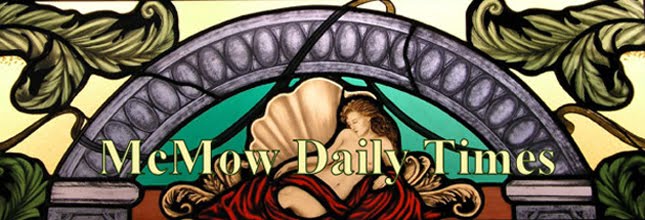Meet Dreamweaver Barbara Wolfe, an artist who found and follows her own dream of bringing light to life through the art glass medium. Barbara is a Dreamweaver who began to develop her skill in Art Glass five years ago in a Beginners Art Class at McMow. For the last year, she has been working in her spare time to build a stained glass lamp from the famous Tiffany "Peony" pattern.

The Peony pattern was created originally by Louis Comfort Tiffany. The pattern below represents one third of the lamp. Notice the dark blue areas. Those represent the spaces that will come together to form the "turban shape" for the finished shade, much like flattening out a globe to see a flat map. Each of the three repeats requires 274 individual cut pieces for a total of 822 precision cuts.

Applying color to the pattern allows Barbara to determine how the colors she has chosen will work together in the overall design.

Primary colors of rich blue, yellow and crimson are framed with vibrant tones of green. The softer pink and lavender tones add just the right balance and sophistication to the pallette. Here are all the pieces for this section cut and fit together on the pattern.

The next step is to take each of the cut pieces and form the "turban" shape. The pattern has been transferred to the mold and the pieces will be applied with "tacky wax" to hold the pieces in shape. This is a necessary step to transform 822 individual pieces of flat glass into one beautiful and complex contoured shape.

All the cut pieces have been assembled on the Peony mold. The next step is to take each piece, one by one, off the mold and apply copper foil to the edges.

After foiling, each piece is re-tacked to the mold. At this point, any of the flat edges that don't perfectly meet the adjoining glass are adjusted with wax filler to make the surface completely smooth before the solder is applied.

Barbara shows us here where this tiny piece was raised with a bit of wax to make it meet up precisely with the larger pieces around it. This is a critical process especially at points like this where the outer curve of the top of the lamp curves inward to meet the bottom band.

All the pieces have been foiled and re-tacked and are now ready for soldering.

This photo best illustrates why it's necessary to "tacky-wax" the pieces on the form and why the form is fixed to a tilt table.

Soldering is the process whereby solid lead is liqufied with heat and applied to the edges of the glass that have been foiled. The foil accepts the molten lead to seal the edges together on the top and in between the pieces.

As each portion is completed, Barbara shifts the mold on the tilt table so she can work on the most horizontal surface a little at a time. The bottom three rows that form the border will not be soldered to the upper lamp at this time because with the inner curve of the bottom border, it would be impossible to remove the shade from the turban shaped mold.

Here the lower edge has been removed and set aside.

This is the outside of the lower portion after it was removed. Notice the unsoldered edge around the perimeter.

The inside of the lower edge will be soldered next and reattached to the upper portion later on.

The "tacky-wax" holding the upper lamp to the mold is softened with heat to loosen the lamp from the mold.

Phil Materio and Tricia Beasley from McMow lend a hand with this delicate process.

A piece this large and complex requires heat to be applied inside the mold as well as outside so the mold will slip out easily and not damage the glass that has only been soldered on the outside.

Ahhhh! Success!

Phil holds the unfinished lamp up to the light to give a hint of how wonderful the final shade will be. The entire interior of the lamp still has to be soldered and bottom rows attached.

Barbara has joined the top and bottom sections and soldered them together on the outside. Now it's time to solder the interior.

Like all great Dreamweavers, Barbara patiently applies the same precision and careful attention to detail when she solders the interior of the lamp.

This beautiful lamp will be hung as a chandelier in Barbara's home when she returns later this Spring. To give us a picture of how lovely this finished lamp will look above her dining room table, Barbara installed the piece on a lamp base. It's just beautiful. Congratulations Barbara and Thank You for sharing this magnificent work in progress.


























































